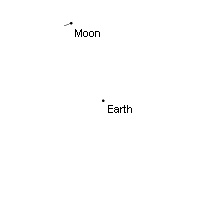 |
Related
links:
Personal report
|
| Animation: some virtual asteroids from the orbital uncertainty region of the asteroid 2000 SG344 approaching the Earth on May 1, 2069 (projection on ecliptic plane). |
THE ORIGIN AND EVOLUTION
OF CELESTIAL BODIES
GRAVITATING IN THE VICINITY
OF EARTH'S ORBIT
Stefan Berinde
-doctoral thesis-
Research supervisor: Prof.Dr. Vasile Ureche
Date of public defence: June 14, 2002
Content
| Introduction
Abbreviations Chapter 1. Population
description
Chapter 2. Dynamics
of close encounters
Chapter 3. Characteristics
of long-term dynamical evolution
|
Chapter
4. Source regions and dynamical transport mechanisms
4.1 The main belt of asteroids as NEA source 4.1.1 Dynamical structure of the asteroid belt 4.1.2 Transport mechanisms to the inner solar system 4.1.3 The role of inter-asteroidal collisions 4.1.4 Estimating the mass of asteroids 4.2 NEA asteroids of cometary origin 4.2.1 Populations of bodies in the outer solar system 4.2.2 Chaotic diffusion of bodies from the Kuiper belt to the inner solar system Chapter 5. Methods
of estimating the impact probability with the Earth
Chapter 6. The SolSyIn
package
List of figures Bibliography Index |
An extended abstract (in English) is available here (PDF format, 0.5 Mb).
The full thesis (in Romanian) is available
here
(PDF format, 1.2 Mb).
 |
Related
links:
Personal report
|
| Animation: some virtual asteroids from the orbital uncertainty region of the asteroid 2000 SG344 approaching the Earth on May 1, 2069 (projection on ecliptic plane). |